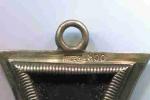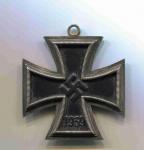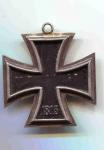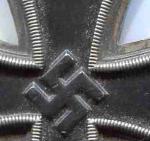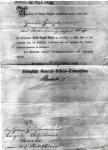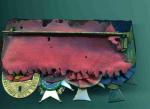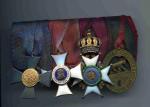-
Posts
809 -
Joined
-
Last visited
Content Type
Profiles
Forums
Blogs
Gallery
Events
Store
Everything posted by Yankee
-

EK 1939 Knights Cross of the Iron Cross
Yankee replied to Yankee's topic in Germany: All Eras: The Iron Cross
I appreciate that, need to tell the poor guy this. -

EK 1939 Knights Cross of the Iron Cross
Yankee replied to Yankee's topic in Germany: All Eras: The Iron Cross
HI A guy had the cross lying around for over 30 years. It measures 49 mm & the beaded rim is slightly higher than the swasstika. What troubled me is the hallmarks not being so readable even with a 10X loop. Thanks -
Dear GMIC members This is way out of my knowledge. Hoping one of the Iron cross collectors can tell me if this is a good example. The markings on the frame is L/3 last number possible 3 not well executed to be certain. 800 as well. Thanks.
-
Hi Chris Do you know if the document states the award being a knight 1st class & that he was in the Artillery branch of service with a rank of Captain? Your thoughts on it being genuine. The paper itself is cream color, folded several times with plenty of empty space, a bit worn, however no seal. The seller says it was purchased back in the early 70's from Graf Klenau. Thanks Sincerely Brian Brian
-
Hello GMIC members Can anybody tell me if this is a genuine transmittal document of the Ernst August Order Knight 1st class from 1866 given to an officer of artillery? As I understand there were no award documents for this order due to the fact it was only in existence for a brief period of time. Is it rare? Thanks in advance.
-
Hi Tifes I think the first scenario in your concluding remarks would be the more likely of the two. Still there is that possibility that the recipient won the swords at a later date. I didn't know the Austrians instituted some swords almost at the end of the Empire. Have seen the crossed swords on higher grades to the Leopold Order but not to a knight. Same with the Iron Crown but again no swords to the 3rd class badge. Is it accurate to think none were ever awarded in the lower class or they do exist and are just extremely rare? A few of the German States had put in place a complex award system for swords which can be a study in itself.
-
Hi Tifes I believe Beau hit the nail on the head. It would be the most likely scenario as stated in post 3. Please note the vast majority of swords given for the 1866 War were Austrian in design. Rothe had won a large contract, there are a few Saxon type from the period but they are rare. The hilt and blade are nearly identical, what sets them apart is the guard. Rothe type is narrow, you can almost think of it being delicate compared to your wider Saxon sword guard. you have a nice genuine badge that one seldom comes across.
-
Strange that the Saxon officer would receive a silver- gilt knight 1st class for that time period. As far as I know all early Saxon Civil Merit orders with swds should be in gold. According to Weber, Arnold & Keil all knight 1st class with swds of the 1st type period 1866-1912 were awarded in gold. The amount awarded 197. However knight 1st class of the 1st type without swds were given both in gold & silver-gilt. From 1815 to 1912 1937 were awarded in gold & 356 in silver-gilt. Interesting to note that the silver-gilt ones are more rare and yet they are cheaper. I suspect yours was manufactured around 1900-1912 just no figures on the amount handed out. A cross over between the two types....
-
That's a really great point. It must have happened all to often where the authorities would bend the rules in allowing the devastating wife or mom keep the insignia. I often come across broken bars and what comes to my mind right away is the work of greedy dealers, unknowing collectors & time itself. Disturbing as this sounds it could be conceivable that the family would be obliged to break apart the bar in order to return the insignia as requested or pay a fee if they had that luxury. I guess there are many circumstances for a broken bar but none have a good ending....
-
I'm just floored to learn how far the authorities would go to keep track of their awards. I read an article that the orders were extremely costly to manufacture which was probably a strong factor in wanting them back. Was there a change of policy later in the 19th century that some German States would allow the family keep the decoration after the recipient died? It would be correct to think it was only the diplomats, senior military who could afford having a duplicate made at his own expense and they'd be private purchase examples that might differ in quality to the ones supplied by the government. I don't think the authorities would be so generous in issuing a second bar. Thanks
-
Thanks for providing a glimpse into the research that can determine the outcome. Sure glade his widow had not returned the insignia, with a full scale war raging on it was probably the last thing on her mind. I suspect the majority of States didn't have some method of listing returns on death of recipient which for collectors can act as a filter to separate original bars and ones put together at a later date. It would be conceivable for a family member to recreate a bar during the post war era to replace the original that had been lost, or destroyed in the war. It would be something to see two identical bars, maybe under those circumstances with the original resurfacing.
-
Werner and Rick your both absolutely brilliant in finding him and providing the award rolls is incredible . Pouring through these rolls with so many other names must be a huge challenge and lots of hours if not days. The documents are a wonder to see which brings life to so many names. Thank you ever so much for your time and the best part is Richard Bruckner is not forgotten :jumping: . Spot on with the SEHO being recycled, not only the configuration of the lions but the badge itself measures 39 mm across which is consistent with earlier examples. I'm glade too that you had the SEHO rolls from 1912. Surprised to learn that he was a native of Saxony-Anhalt but yet his Bear is placed last... It would be safe to say he never served during WWI in any capacity. Sincerely Brian
-
I appreciate you shedding some light when the bar was put together. I never considered the SEHO being recycled. After reading your thoughtful comments I did recall seeing a Napoleonic St. Henry on a bar where the other orders and medals were of a later period. I have seen many a fine bar on the forum from the late 1800's and onwards having ribbon in good to mint condition which was another reason why I had initially dated mine( frayed ) to an earlier period. If you ever decide to write a book on "Bars" I'll be the first on line.
-
I hope the scan helps in determining the date of the bar. The SEHO has the earlier type type Lion between the arms. The later pieces will only have the paw reaching out to the cross and the Lion is thinner in design. I never took into consideration that the bar was put together at a much later date. Thanks again.
-
I didn't think it was possible to identify the recipient. The SEHO is rather small which makes me believe the bar is 1860-70 and as you pointed out no 1897 Centenary. Thanks Rick in advance if you come across any further info on the bar. Possible to be Prussian, receiving a higher grade Crown & Red Eagle.
-
That is really great you were able to provide the info in detail what one had to do to receive the medal and that it was the individual soldier to determine which battle clasps he was to receive and right to wear. Thanks for that great information. Sincerely Yankee
-
Thanks ever so much for providing a list of bars for each medal. Both medals are very similar in design and the reverse on both have the same dedication. What was the criteria of awarding the medals and how did it differ from each other? Was thinking perhaps it was the awarding of the campaign bars that would be the deciding factor which medal the recipient was to receive.I read that the medals were given to all who participated in the conflict however the medals are not common to support such a belief especially the medal for the Civil War 1873-1874. What would be the most bars a soldier could receive? The scan that you provided illustrates 13 bars is for show or somebody had that combination. Great web site!!! Sincerely Yankee
-
Greetings Can anybody provide a list of named bars that were awarded on the 1875 medal of Alfonso XII also a list to the Civil War medal of 1873-1874. Thanks in advance Estella, Junquera, Monte-Jura, Santa Barbara, Oria, Pamplona, Cantavieja, Miravalles, Eigueta, Trevino, PenaPlata. All I came up with. Sincerely Yankee


